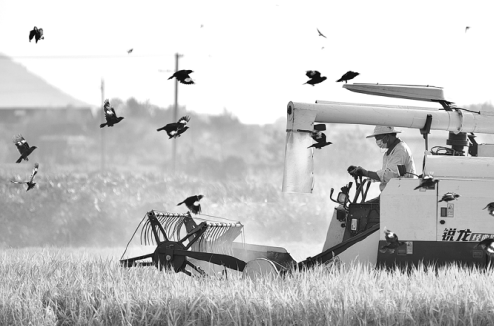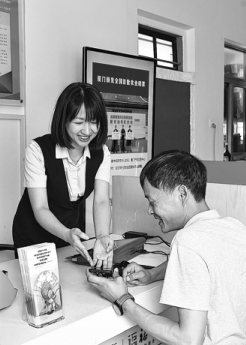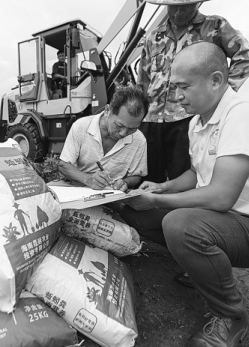Tea gardens go green
To reduce greenhouse gas emissions and increase carbon sink capacity, tea plantations and farmlands in Fujian province have adopted novel methods, write Zhao Yimeng in Beijing and Hu Meidong in Fuzhou

Agricultural activities contribute about 30 percent of the total global greenhouse gas (GHG) emissions, mainly due to the use of chemical fertilizers, pesticides and animal wastes, but agricultural ecosystems can also offset 80 percent of the emissions, according to data from the United Nations Food and Agriculture Organization.
The carbon sequestration potential of farmlands has been studied more closely in recent years, with the Ministry of Agriculture and Rural Affairs releasing an action plan this year to reduce GHG emissions from farmlands and rural areas.
The ministry's action plan is aimed at boosting the recycling of straw and stubs, increasing the use of organic fertilizers, and intensifying the development of high-standard farmland to strengthen the carbon sequestration and carbon retention capacity of tea plantations and fruit orchards.
Tea gardens in South China's Fujian province are seen as a sally port for reducing agricultural GHG emissions thanks to their high plant coverage.
A major tea-producing county with 40,000 hectares of tea plantations in southeastern Fujian, Anxi has been promoting techniques to reduce carbon emissions, among other things, by growing high-yield varieties, closer planting of tea plants to boost photosynthesis, and using smart pest-prevention methods to reduce the use of chemical pesticides.
Li Zhipeng, a researcher at the provincial academy of agricultural sciences, said that despite being one of the biggest sources of GHG emissions, farmlands also have huge carbon sink capacity. For example, the expansive green cover and large plant canopies in tea plantations create favorable conditions for photosynthesis. And the fact that a lot of branches and leaves are pruned every year in tea plantations helps develop carbon pools on the soil surface, Li told Fujian Daily.
To determine the carbon sink capacity of tea plantations, accurate GHG or carbon emissions calculations are needed.
Accordingly, a metrological observation system has been introduced in a smart farm in Anxi. It records weather information such as the temperature, and precipitation and radiation levels that help determine the carbon sink capacity.
Wang Miaomiao at the academy's Institute of Digital Agriculture said tea plantations sequestrate carbon in two ways. They absorb carbon dioxide (CO2) through photosynthesis and their soil soaks up organic carbon.
Researchers used the data obtained from the new metrological observation system to deduce the carbon flux of tea plants through the ecological process, and estimate the soil's organic carbon storage capacity through laboratory analysis.
Huang Wenbiao, an official in the provincial agricultural and rural affairs department, said that although it could take years to calculate the carbon sink capacity in tea plantations, the experience and knowledge gained from carbon sequestration in forests can be applied to the agricultural sector, especially to set trading rules and develop related financial products. Carbon sink trading can be introduced first to the agricultural sector, especially in plantations and aquaculture, to achieve carbon neutrality, he said.
Animal husbandry accounts for a large percentage of global GHG emissions. Large volumes of methane, a non-CO2 and relatively toxic greenhouse gas, are emitted by ruminants and during the waste fermentation of livestock and poultry. In contrast, fruit trees and tea plants have strong carbon sequestration capability, Huang said.
To reduce GHG emissions and increase farmlands' carbon sink capacity, the authorities launched the first agricultural carbon sink trading platform in Xiamen, Fujian, on May 5, to provide services for developing, measuring and trading carbon sink. The first batch of two-year "carbon tickets" for increasing carbon sink capacity was issued on the same day in two villages with large areas under tea plantation.
Carbon tickets are issued by a thirdparty agency to monitor and evaluate crops with clear ownership, and submit reports that will help calculate agricultural carbon sinks within a certain range.
Yinlu, a Xiamen-based food company, purchased two tickets with 3,357 metric tons of carbon sink in tea plantations with the aim of cashing in on the carbon ticket offer.
"In the past, we only knew how to sell tea. Now, we can sell air too, thanks to the development of carbon sink in tea plantations," said Gao Quanwei, a village Party secretary in Xiamen.
The money will be used to better protect the local environment and the mountains and rivers in and around the village, Gao said.
In late August, the tea industry development center of Fuding city signed a contract with the Fujian provincial bureau of China Life, a leading Chinese insurance company, to provide compensation worth 3 million yuan ($428,000) for carbon sink loss.
The company analyzes and monitors the carbon sequestration capacity of different crops, and claims insurance based on carbon sequestration loss, said Liu Feng, an employee responsible for research and development of agricultural insurance products at the company.
The insurance covers the loss of carbon sink caused by natural disasters such as fire, freezing, and mudslide, as well as deficiencies such as insufficient soil fertility in plantations and field management failures, Liu told Fujian Daily.
When the loss of carbon sink reaches the standard stipulated in the insurance contract, the company compensates the insured for the loss, he said. The first batch of pilot insured targets includes 2,000 hectares of tea plantations and farmlands in Fuding.
While the insurance amount has reached 3 million yuan, the annual premium is 240,000 yuan. The insurance indemnity can be used by the government departments to increase carbon sink capacity after a disaster, and improve soil fertility and plantation management.
"After an accident (or natural disaster), the insurance company will efficiently monitor the loss with remote sensing technology, and pay the compensation as soon as possible," Liu said, adding that no loss notice has been submitted since the insurance program was launched.
This is good news, considering that sinks are being created for more than 200,000 tons of carbon each year, according to Zhang Qingbi, director of the center, in the tea farms in Fuding.
Yang Jie in Fuzhou contributed to this story.




Today's Top News
- China's industrial profits down 1.8% in H1
- Thailand responds to Trump's ceasefire call
- Recall vote shows DPP's manipulation runs against Taiwan people's will: mainland spokesperson
- Top DPRK leader visits China-DPRK Friendship Tower
- China proposes global cooperation body on AI
- Scholars propose inclusive human rights framework






























